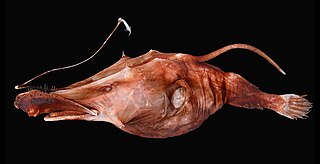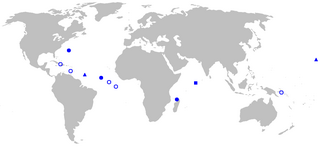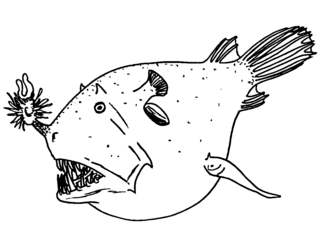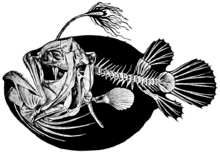
Goosefishes are anglerfishes in the family Lophiidae found in the Arctic, Atlantic, Indian, and Pacific Oceans, where they live on sandy and muddy bottoms of the continental shelf and continental slope, to depths of more than 1,000 m (3,300 ft). Like most other anglerfishes, they have a very large head with a large mouth that bears long, sharp, recurved teeth. Also like other anglerfishes, the first spine of the spinous dorsal fin has been modified as an angling apparatus (illicium) that bears a bulb-like or fleshy lure (esca).

Leftvents are small, deep-sea lophiiform fish comprising the family Linophrynidae distributed throughout tropical to subtropical waters of all oceans.

Linophryne arborifera, or illuminated netdevil, is an anglerfish of the family Linophrynidae, found in all tropical and subtropical oceans at depths below 1,000 m (3,300 ft) in the Bathyal zone. Its length is up to 77 mm. The female is significantly larger than the mature, parasitic male.

The triplewart seadevil is a sea devil of the family Ceratiidae and the order Lophoiiformes. This species is the only member of its genus. Noted for its extreme sexual dimorphism, the triplewart seadevil's length ranges from 20 to 30 cm for females and 1 to 3 cm for males.
Bertella idiomorpha is a species of deep-sea anglerfish found in the northern Pacific Ocean. It is the only species in the genus Bertella, in the family Oneirodidae, and can be distinguished from other members of the family by the structure of its hyomandibular bone.

The horned lantern fish or prickly seadevil is a deep-sea anglerfish found worldwide. It is the sole species in the family Centrophrynidae, distinguished from other deep-sea anglerfishes by various characters including four pectoral radials, an anterior spine on the subopercular bone, and a short hyoid (chin) barbel in both sexes.

The toothed seadevil, spiny seadevil or netbeard seadevil, (Neoceratias spinifer), is a rarely seen deep-sea anglerfish found in the mesopelagic and bathypelagic zones of the western central Pacific Ocean. It is the only species in the family Neoceratidae, and is unique amongst the deep-sea anglerfish in lacking an illicium and esca, and in having large teeth placed on the outside of its jaws.
Spiniphryne gladisfenae, also known as the prickly dreamer, is a species of dreamer. Dreamers are a type of deep sea anglerfish known only from the Atlantic Ocean. Anglerfish are classified by how they lure their prey. Female anglerfish have a piece of dorsal spine that protrudes above their mouth and is luminescent in order to attract prey. The females of the species Spiniphryne gladisfenae can grow to a length of 10.5 centimetres (4.1 in) SL. The esca contains two bulbous appendages on the tip, covered with tiny papillae and with clusters of tiny filaments around the base. There is also a large appendage on the back, divided at the end into three lobes or many filaments. The number of lateral escal filaments varies from none to three. S. gladisfenae also has fewer dental teeth than S. duhameli.

Phyllorhinichthys is a genus of dreamers. Like other oneirodids, they are small, bathypelagic fish with bioluminescent lures. Phyllorhinichthys is unique amongst the deep-sea anglerfish in having a pair of fleshy, leaf-like structures on its snout.

The Wonderfish (Thaumatichthys) is a genus of deep-sea anglerfish in the family Thaumatichthyidae, with three known species. Its scientific name means "wonder-fish" in Greek; oceanographer Anton Bruun described these fishes as "altogether one of the oddest creatures in the teeming variety of the fish world." In contrast to other anglerfishes, the bioluminescent lure of Thaumatichthys is located inside its cavernous mouth. They are worldwide in distribution and are ambush predators living near the ocean floor.

The compleat anglerfish (Lasiognathus) is a genus of deep-sea anglerfish in the family Thaumatichthyidae, with six species known from the Atlantic and Pacific Oceans. Its lure apparatus appears to consist of a fishing rod, a fishing line, bait, and hooks. It is also distinctive for an enormous upper jaw with premaxillaries that can be folded down to enclose the much shorter lower jaw.

The anglerfish are fish of the teleost order Lophiiformes. They are bony fish named for their characteristic mode of predation, in which a modified luminescent fin ray acts as a lure for other fish. The luminescence comes from symbiotic bacteria, which are thought to be acquired from seawater, that dwell in and around the sea.

Black seadevils are small, deepsea lophiiform fishes of the family Melanocetidae. The five known species are all within the genus Melanocetus. They are found in tropical to temperate waters of the Atlantic, Indian, and Pacific Oceans, with one species known only from the Ross Sea.

The humpback anglerfish is a species of black seadevils in the family of Melanocetidae, which means "black whale" in Greek. The species is named after James Yate Johnson, the English naturalist who discovered the first specimen in Madeira in 1863. The common names include anglerfish, viperfish and fangtoothfish.

Rhynchactis is a genus of deep-sea anglerfish in the family Gigantactinidae, containing three species found worldwide at depths greater than 400 m (1,300 ft). Adult female Rhynchactis reach a standard length (SL) of 11–13 cm (4.3–5.1 in) and have a dark-colored, streamlined body and a relatively small head bearing a very long illicium. Unlike almost all other deep-sea anglerfishes, the illicium bears no bioluminescent esca at the tip. The mouth is almost devoid of teeth, and the inside of both jaws are covered by numerous white glands that are unique to this genus.

Borophryne apogon, the netdevil, or greedy seadevil, is a species of leftvent anglerfish known today from the waters of the eastern Pacific Ocean off the Central American coast. It is found at depths down to around 1,750 m (5,700 ft). This species grows to a length of 8.3 centimetres (3.3 in) TL. A fossil specimen of this species has been found in the Los Angeles Basin dating back to the Late Miocene, some eight million years ago.

Oneirodes is a genus of fish in the family Oneirodidae.
Lasiognathus dinema is a species of wolftrap angler found in the deep waters of the northern Gulf of Mexico. It is found at depths of around 3,280 to 4,900 feet.

Linophryne indica, or headlight angler, is a leftvent anglerfish in the family Linophrynidae, found in the bathyal zone of the Pacific Ocean at depths below 1,000 m (3,300 ft). The female is significantly larger than the mature male. A fossil specimen of this species has been found in the Los Angeles Basin dating back to the Late Miocene, some eight million years ago.

Gigantactis paxtoni is a species of fish in the whipnose angler (Gigantactinidae) family, first described in 1981 by Erik Bertelsen, Theodore Wells Pietsch III and Robert J. Lavenberg. The species epithet, paxtoni, honours John Paxton of the Australian Museum.


















